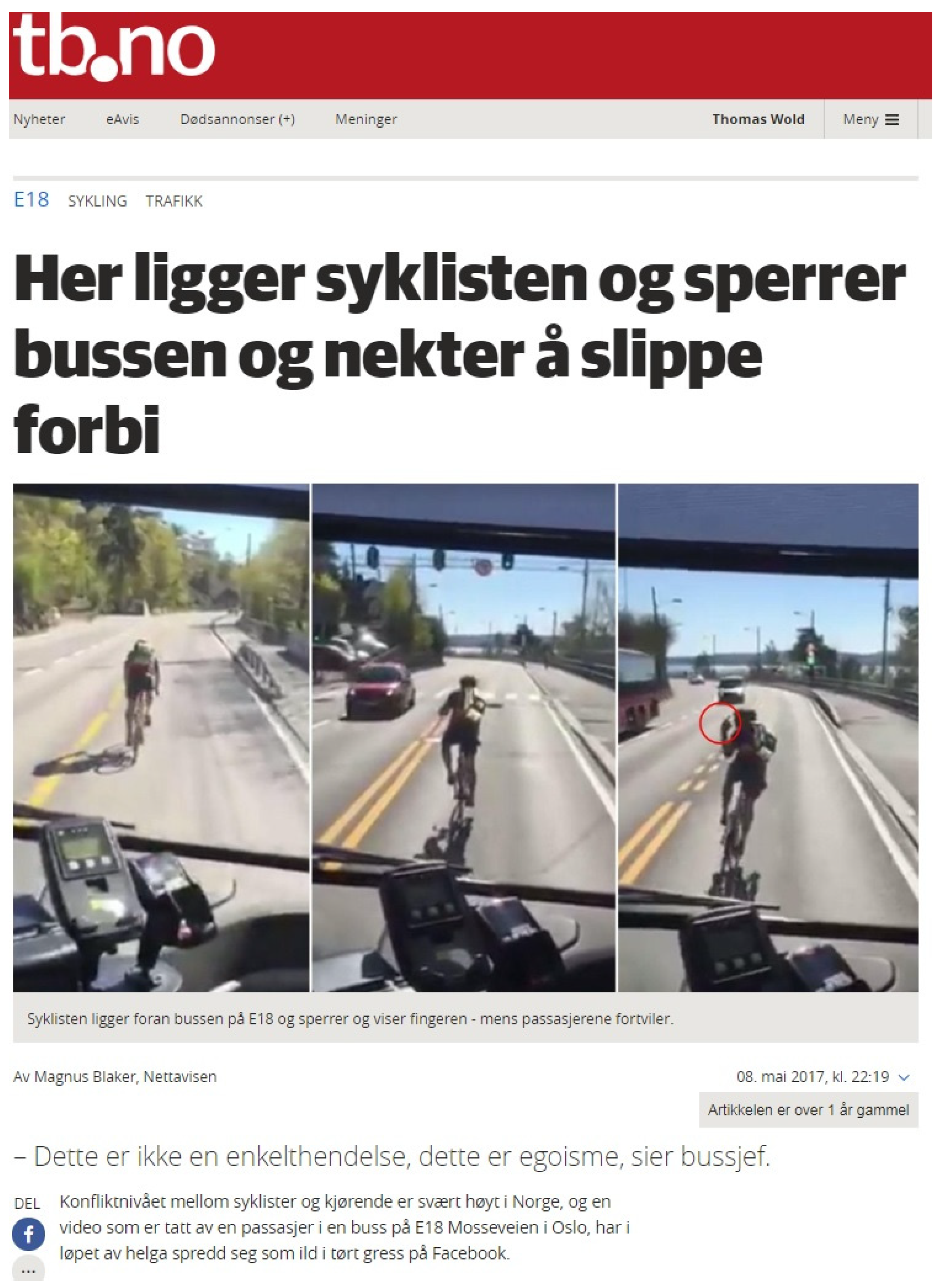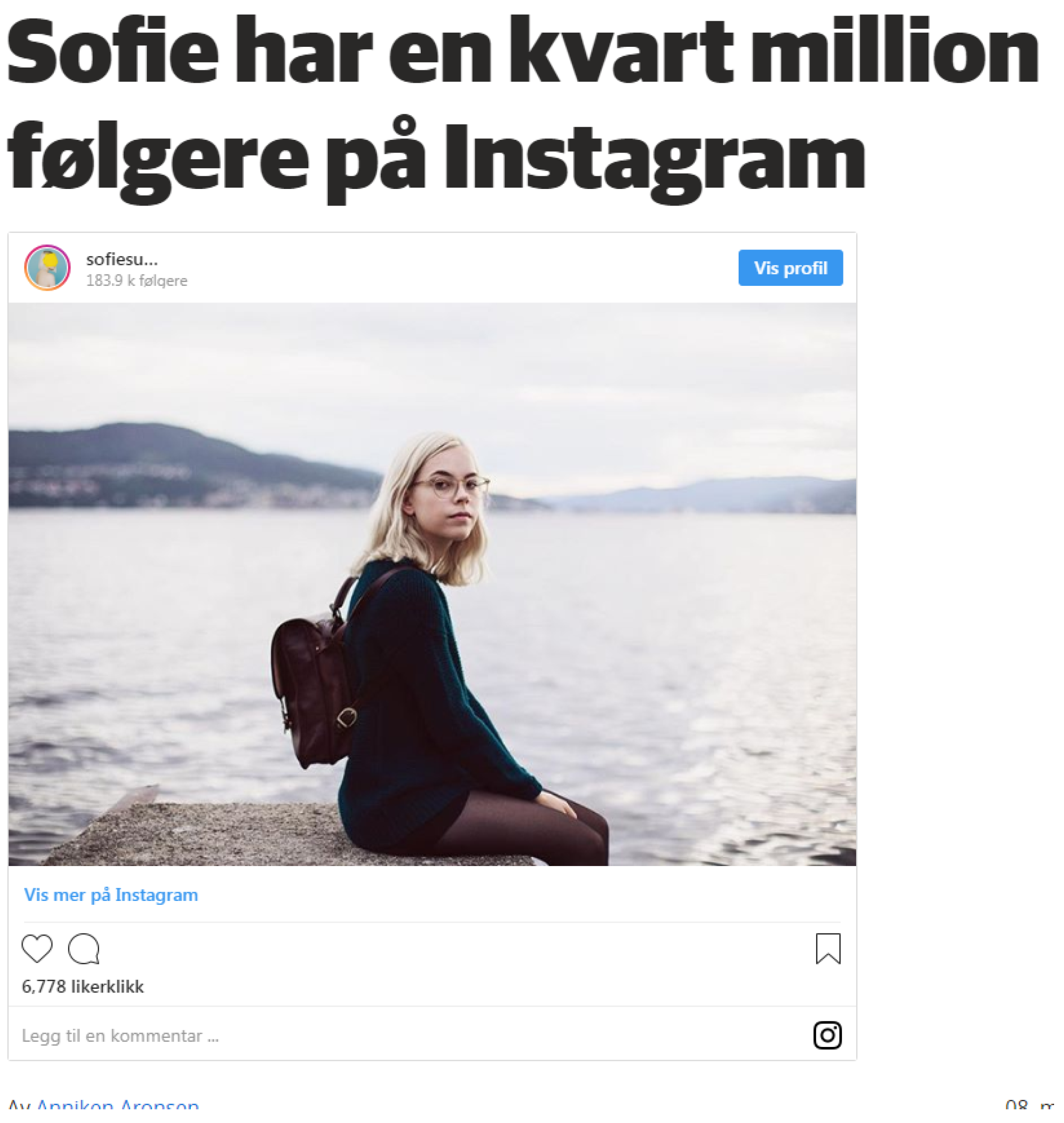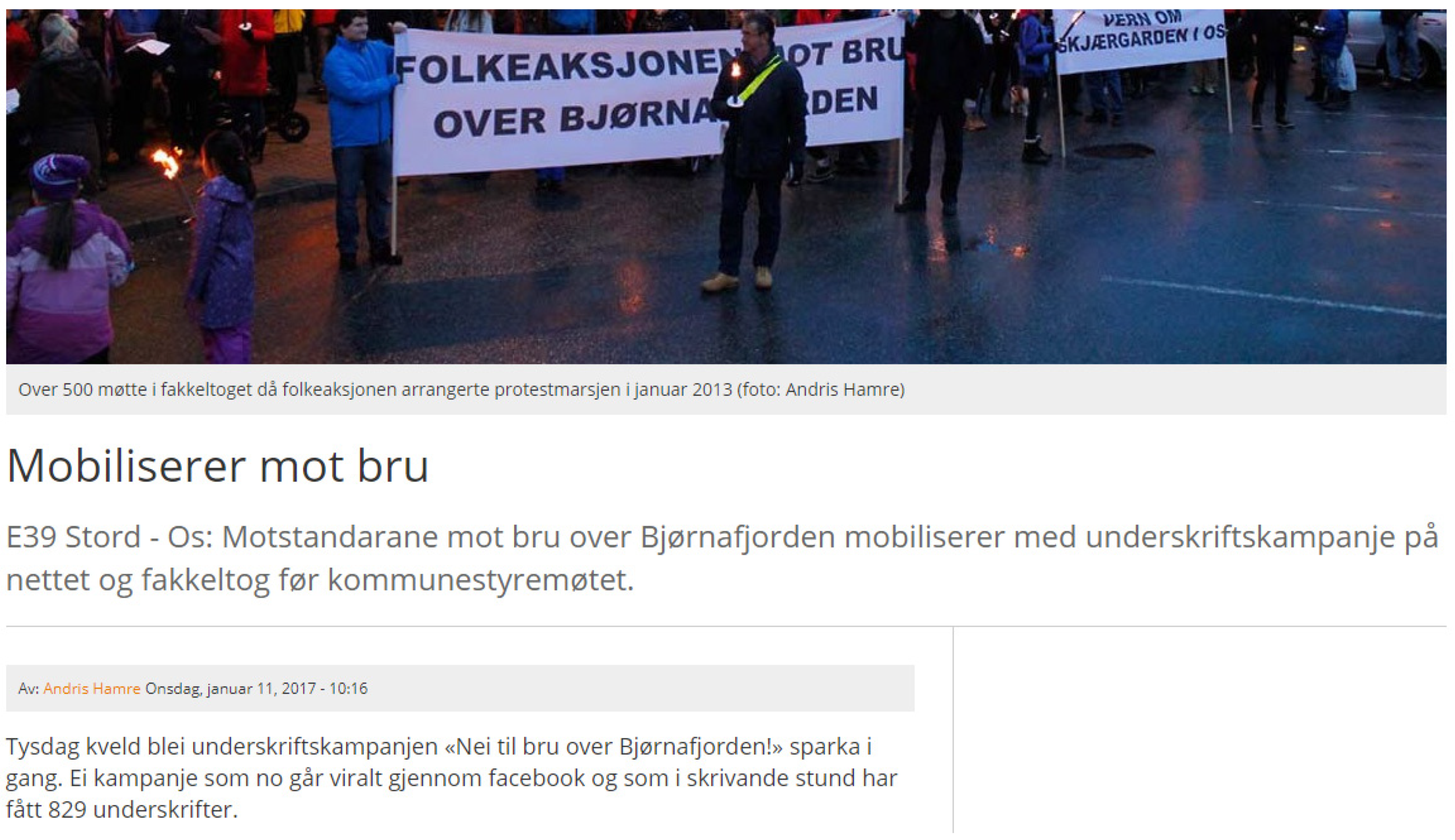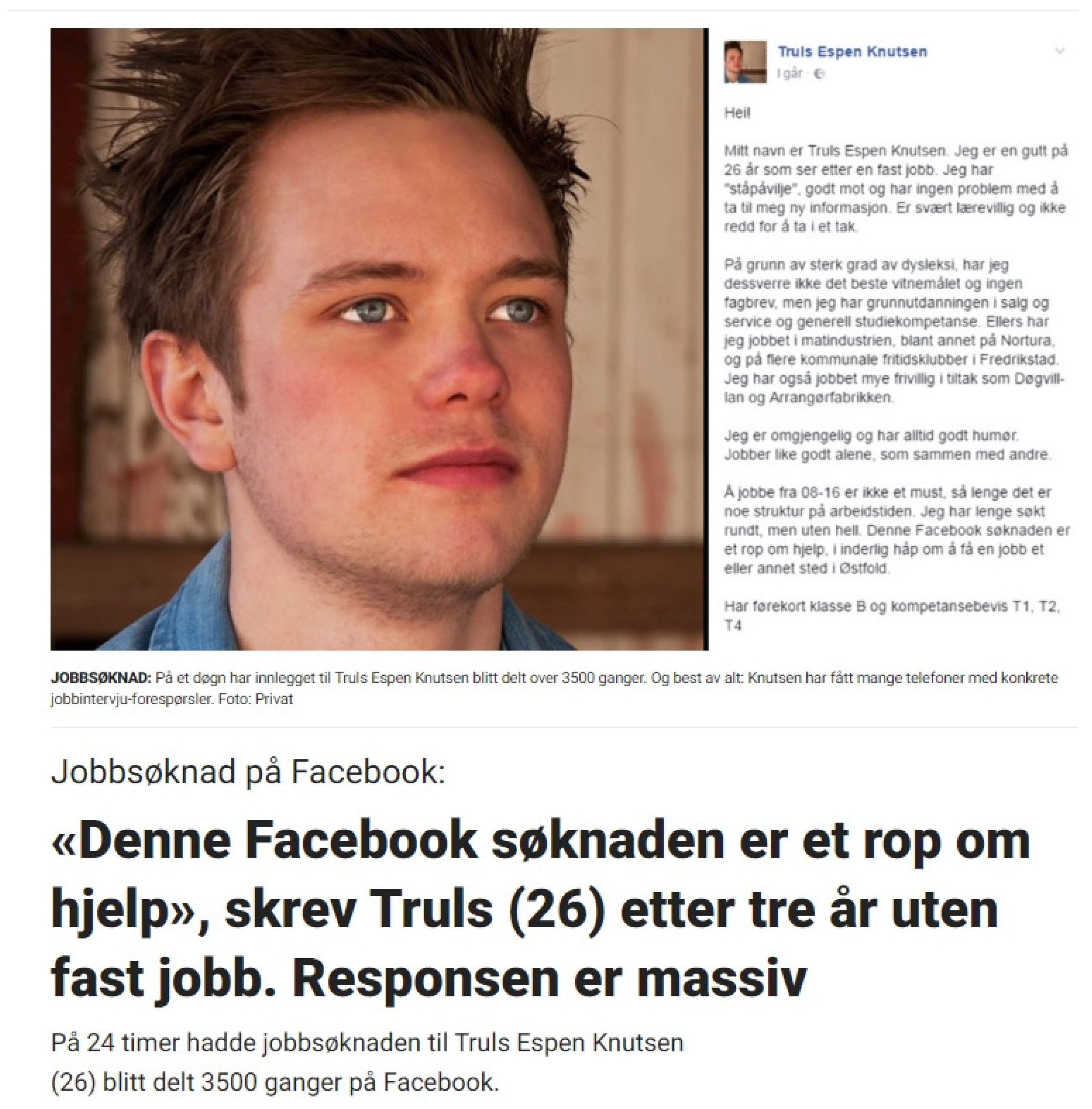Ordinary People and Social Media as Sources in Norwegian Newspapers
Abstract
1. Introduction
2. Ordinary People in the News
2.1. Social Media as a Source in News Production
2.2. Journalistic Presentation
2.3. News Criteria
3. Method
- Norwegian online newspapers only were selected. Paper editions, radio, and TV were not included.
- Only editor-controlled online newspapers were included. Alternative news sites, weekly magazines, and viral sites were excluded.
- The main content of the news story had to be based on a social media post. Stories in which tweets or other quotes from social media were used as additional elements in a larger story were not included.
- The social media posts had to be by ordinary people, who in the present context are understood as people who are not media personalities, and who do not hold positions that are scrutinized by the media.
3.1. Data Collection
3.2. Analysis
- Politics (including war and terrorism, demonstrations, public administration, harassment, political humor, and regional politics)
- Economy (including personal economy, business, finance, and markets)
- Crime (including murders, violence, trafficking, policy issues, and trials)
- Social issues (including work, health and education, environmental issues, consumer, construction, animal welfare, and traffic issues)
- Culture (including the arts, media, royalty, curiosities, leisure, nature photos, and popular culture)
- Sports
- Accidents
- Weather
- Science and technology issues
3.3. Limitations
4. Results
4.1. A Variety of Topics
4.1.1. Social Issues
Consumer Action
Traffic Issues
4.1.2. Culture
Curiosities
Media
Leisure
4.1.3. Politics
Humor and Harassment
4.1.4. Advertisements
4.2. Gender and Age of the Sources
4.3. User-Generated Visuals: Photos and Videos
4.4. Additional Sources
4.5. Virality as a News Criteria
4.6. Geography
5. Summary and Discussion
6. Conclusions
7. Further Research
Funding
Institutional Review Board Statement
Informed Consent Statement
Conflicts of Interest
References
- Aalberg, Toril, and Eiri Elvestad. 2012. Mediesosiologi. Oslo: Det Norske Samlaget. [Google Scholar]
- Allern, Sigurd. 1996. Kildenes Makt. Ytringsfrihetens Politiske Økonomi. Oslo: Pax. [Google Scholar]
- Allern, Sigurd. 2015. Journalistikk og Kildekritisk Analyse. Oslo: Cappelen Damm Akademisk. [Google Scholar]
- Almgren, Susanne M., and Tobias Olsson. 2016. Commenting, Sharing and Tweeting News. Nordicom Review 37: 67–81. [Google Scholar] [CrossRef]
- Al-Rawi, Ahmad. 2017. Viral News on Social Media. Digital Journalism 7: 63–79. [Google Scholar] [CrossRef]
- Andén-Papadopoulos, Kari, and Mervi Pantti. 2013. Re-imagining crisis reporting: Professional ideology of journalists and citizen eyewitness images. Journalism 14: 960–77. [Google Scholar] [CrossRef]
- Bergström, Annika, and Ingela Wadbring. 2014. Beneficial yet crappy: Journalists and audiences on obstacles and opportunities in reader comments. European Journal of Communication 30: 137–51. [Google Scholar] [CrossRef]
- Brandtzaeg, Petter Bae, Marika Lüders, Jochen Spangenberg, Linda Rath-Wiggins, and Asbjørn Følstad. 2016. Emerging Journalistic Verification Practices Concerning Social Media. Journalism Practice 10: 323–42. [Google Scholar] [CrossRef]
- Brandtzaeg, Petter Bae. 2012. Social Implications of the Internet and Social Networking Sites—A User Typology Approach. Ph.D. thesis, University of Oslo, Oslo, Norway. [Google Scholar]
- Bro, Peter, and Filip Wallberg. 2014. Digital Gatekeeping. Digital Journalism 2: 446–54. [Google Scholar] [CrossRef]
- Broersma, Marcel, and Todd Graham. 2012. Social media as beat. Journalism Practice 6: 403–19. [Google Scholar] [CrossRef]
- Bruns, Alex. 2005. Gate-Watching: Collaborative Online News Production. New York: Peter Lang. [Google Scholar]
- Bruns, Alex. 2016. ‘Random Acts of journalism’ Redux: News and social media. In News Across Media. Production, Distribution and Consumption. Edited by Jakob Linaa Jensen, Mette Mortensen and Jacob Ørmen. New York: Routledge, pp. 32–47. [Google Scholar]
- Buckingham, David. 2008. Introducing Identity. In Youth, Identity, and Digital Media. Edited by David Buckingham. The John D. And Catherine T. Macarthur Foundation Series on Digital Media and Learning. Cambridge, MA: The MIT Press, pp. 1–24. [Google Scholar]
- Chadwick, Andrew. 2011. The Political Information Cycle in a Hybrid News System: The British Prime Minister and the “Bullygate” Affair. The International Journal of Press/Politics 16: 3–29. [Google Scholar] [CrossRef]
- Chadwick, Andrew. 2013. The Hybrid Media System: Politics and Power. Oxford: Oxford University Press. [Google Scholar]
- Dahlgren, Peter. 2009. Media and Political Engagement: Citizens, Communication and Democracy. Cambridge: Cambridge University Press. [Google Scholar]
- Dahlstrøm, Hilde Kristin, and Liv Iren Hognestad. 2016. Nedbemanning som utfordring for journalistikken. Norsk Medietidsskrift 22: 2–19. [Google Scholar] [CrossRef]
- Dahlstrøm, Hilde Kristin, Nina Skråmestø Nesheim, and Bjørg M. Nyjordet. 2017. Barn og eldre marginaliseres som kilder i mediene. Norsk medietidsskrift 24: 1–22. [Google Scholar] [CrossRef]
- Davis, Janny L., and Tony P. Love. 2018. Generalizing from social media data: A formal theory approach. Information, Communication & Society 22: 637–47. [Google Scholar] [CrossRef]
- Duckert, Fanny, and Kim Edgar Karlsen. 2017. I medienes Søkelys: Eksponering, Stress og Mestring. Oslo: Gyldendal akademisk. [Google Scholar]
- Elgesem, Dag, Hallvard Moe, Helle Sjøvaag, Eirik Stavelin, Maren Agdestein, Joachim Laberg, Linn Lorgen, and Gyri Smørdal Losnegaard. 2010. Nrks Nyhetstilbud På Internett I 2009 [the Internet News Service of the Norwegian Public Broadcasting (Nrk)]. Bergen: Univeristy of Bergen. Available online: https://monc.w.uib.no/ressurser-3/nrks-nyhetstilbud-pa-internett-i-2009/ (accessed on 7 November 2022).
- Elgesem, Dag. 2015. Consent and information ethical considerations when conducting research on social media. In Internet Research Ethics. Edited by Hallvard Fossheim and Helen Ingierd. Norway: Cappelen Damm Akademisk. [Google Scholar]
- Elvestad, Eiri, and Angela Philips. 2018. Misunderstanding News Audiences. Seven Myths of the Social Media Era. London: Routledge. [Google Scholar]
- Eronen, Maria. 2015. Rhetoric of Self-Expressions in Online Celebrity Gossip. Ph.D. thesis, University of Wasa, Vaasa, Finland. [Google Scholar]
- Farhi, Paul. 2009. The Twitter Explosion. American Journalism Review 31: 26. [Google Scholar]
- Ferreira, Ricardo Ribeiro. 2021. Liquid Disinformation Tactics: Overcoming Social Media Countermeasures through Misleading Content. Journalism Practice 16: 1537–58. [Google Scholar] [CrossRef]
- Forsythe, Sydney. A. 1950. An Exploratory Study of Letters to the Editor and Their Contributors. Public Opinion Quarterly 14: 143–44. [Google Scholar] [CrossRef]
- Gans, Herbert J. 2004. Deciding What’s News: A Study of CBS Evening News, NBC Nightly News, Newsweek, and Time. Evanston: Northwestern University Press. [Google Scholar]
- Goffman, Erving. 1956. The Presentation of Self in Everyday Life. Edinburgh: University of Edinburgh. [Google Scholar]
- Grøtte, Marit. 2015. Norsk kjendisjournalistikk på nett. Norsk Medietidsskrift 22: 1–25. [Google Scholar] [CrossRef]
- Hermida, Alfred, and Neil Thurman. 2008. A clash of cultures. Journalism Practice 2: 343–56. [Google Scholar] [CrossRef]
- Hermida, Alfred, Fred Fletcher, Darryl Korell, and Donna Logan. 2012. Share, Like, Recommend. Journalism Studies 13: 815–24. [Google Scholar] [CrossRef]
- Hladík, Radim, and Václav Štětka. 2015. The Powers that Tweet. Journalism Studies 18: 154–74. [Google Scholar] [CrossRef]
- Hodkinson, Paul. 2016. Bedrooms and beyond: Youth, identity and privacy on social network sites. New Media & Society 19: 272–88. [Google Scholar] [CrossRef]
- Holt, Kristoffer, and Michael Karlsson. 2015. Random acts of journalism?: How citizen journalists tell the news in Sweden. New Media & Society 17: 1795–810. [Google Scholar] [CrossRef]
- Ihlebæk, Karoline Andrea, and Arne H. Krumsvik. 2015. Editorial power and public participation in online newspapers. Journalism: Theory, Practice & Criticism 16: 470–87. [Google Scholar] [CrossRef]
- Jensen, Jakob Linna. 2016. The Social Sharing of News. Gatekeeping and opinion leadership on Twitter. In News Across Media. Production, Distribution and Consumption. Edited by Jakob Linna Jensen, Mette Mortensen and Jacob Ørmen. New York: Routledge, pp. 142–61. [Google Scholar]
- Jönsson, Anna Maria, and Henrik Örnebring. 2011. User-Generated Content and the News. Journalism Practice 5: 127–44. [Google Scholar] [CrossRef]
- Ju, Alice, Sun Ho Jeong, and Hsiang Iris Chyi. 2013. Will Social Media Save Newspapers? Journalism Practice 8: 1–17. [Google Scholar] [CrossRef]
- Kalsnes, Bente, and Anders Olof Larsson. 2017. Understanding News Sharing Across Social Media. Journalism Studies 19: 1669–88. [Google Scholar] [CrossRef]
- Kalsnes, Bente. 2016. Intermedia Agenda Setting. Political Journalists’ Source Hunting on Social Media. In News Across Media. Production, Distribution and Consumption. Edited by Jensen Jakob Linna, Mette Mortensen and Jacob Ørmen. New York: Routledge. [Google Scholar]
- Karlsson, Michael, Annika Bergström, Christer Clerwall, and Karin Fast. 2015. Participatory journalism—The (r)evolution that wasn’t. Content and user behavior in Sweden 2007–2013. Journal of Computer-Mediated Communication 20: 295–311. [Google Scholar] [CrossRef]
- Kurpius, David D. 2002. Sources and Civic Journalism: Changing Patterns of Reporting? Journalism & Mass Communication Quarterly 79: 853–66. [Google Scholar] [CrossRef]
- Larsson, Andres Olof, and Karoline Andrea Ihlebæk. 2016. Beyond “J-Tweeters”. Journalism Practice 11: 689–704. [Google Scholar] [CrossRef]
- Lee, Chei Sian, and Long Ma. 2012. News sharing in social media: The effect of gratifications and prior experience. Computers in Human Behavior 28: 331–39. [Google Scholar] [CrossRef]
- Mäenpää, Jenni. 2014. Rethinking Photojournalism. The Changing Work Practices and Professionalism of Photojournalists in the Digital Age. Nordicom Review 35: 91–104. [Google Scholar] [CrossRef]
- Marwick, Alice E., and Danah Boyd. 2014. Networked privacy: How teenagers negotiate context in social media. New Media & Society 16: 1051–67. [Google Scholar] [CrossRef]
- McCombs, Maxwell. 2005. A Look at Agenda-setting: Past, present and future. Journalism Studies 6: 543–57. [Google Scholar] [CrossRef]
- Medienorge. 2021. Use of Social Media on an Average Day. University of Bergen. Available online: https://medienorge.uib.no/statistikk/medium/ikt/412 (accessed on 20 March 2022).
- Messner, Marcus, and Marcia Watson Distaso. 2008. The Source Cycle. Journalism Studies 9: 447–63. [Google Scholar] [CrossRef]
- Mortensen, Mette. 2016. Breaking news and engaging users. User images and the construction of presence in television coverage of extreme weather. In News Across Media. Production, Distribution and Consumption. Edited by Jakob Linna Jensen, Mette Mortensen and Jacob Ørmen. New York: Routledge. [Google Scholar]
- Näsi, Altti. 2015. The Reader’s Image: Amateur Photographs in the Finnish Newspaper. In Integrated Media Change. Edited by Ritta Brusila, Ann-Kristin Juntti-Henriksson and Hannu Vanhan. Rovaniemi: Lapland University Press, pp. 111–32. [Google Scholar]
- Olsson, Åke. 1984. Maktens Kronikører. Om Underklass och överklass i svenska Nyhetsmedier. Stockholm: Författerförlaget. [Google Scholar]
- Palmer, Ruth. 2018. Becoming the News: How Ordinary People Respond to the Media Spotlight. New York: Columbia University Press. [Google Scholar]
- Pantti, Mervi, and Piet Bakker. 2009. Misfortunes, memories and sunsets. International Journal of Cultural Studies 12: 471–89. [Google Scholar] [CrossRef]
- Pantti, Mervi, and Stefanie Sirén. 2015. The Fragility of Photo-Truth. Digital Journalism 3: 495–512. [Google Scholar] [CrossRef]
- Paulussen, Steve, and Raymond A. Harder. 2014. Social Media References in Newspapers. Journalism Practice 8: 542–51. [Google Scholar] [CrossRef]
- Rogstad, Ingrid Dahlen. 2014. Political News Journalists in Social Media. Journalism Practice 8: 688–703. [Google Scholar] [CrossRef]
- Schmieder, Kathrin. 2015. Amateur Photographs as Visual Quotes. Journalism Practice 9: 580–96. [Google Scholar] [CrossRef]
- Singer, Jane B. 2014. User-generated visibility: Secondary gatekeeping in a shared media space. New Media & Society 16: 55–73. [Google Scholar] [CrossRef]
- Singer, Jane B., David Domingo, Ari Heinonen, Alfred Hermida, Steve Paulussen, Thorsten Quandt, Zvi Reich, and Marina Vujnovic. 2011. Participatory Journalism: Guarding Open Gates at Online Newspapers. Chichester: Wiley Blackwell. [Google Scholar]
- Sjøvaag, Helle, and Nina Kvalheim. 2019. Eventless news: Blindspots in journalism and the ‘long tail’ of news content. Journal of Applied Journalism & Media Studies 8: 291–310. [Google Scholar] [CrossRef]
- Sjøvaag, Helle, Hallvard Moe, and Eirik Stavelin. 2012. Public service news on the web. Journalism Studies 13: 90–106. [Google Scholar] [CrossRef]
- Skogerbø, Eli, and Hallvard Moe. 2015. Twitter på tvers–koblinger mellom journalister og politikere. Norsk Medietidsskrift 22: 1–21. [Google Scholar] [CrossRef]
- Skogerbø, Eli, and Rune Karlsen. 2014. Mediatisation and Regional Campaigning in a Party Centred-System. Javnost-The Public 21: 75–92. [Google Scholar] [CrossRef]
- Tuchman, Gaye. 1978. Making News: A Study in the Construction of Reality. New York: Free Press. [Google Scholar]
- Turkle, Sherry. 1996. Life on the Screen: Identity in the Age of the Internet. London: Weidenfeld & Nicholson. [Google Scholar]
- Turner, Graeme. 2010. Ordinary People and the Media. The Demotic Turn. New York: Sage Publications Ltd. [Google Scholar]
- Vaage, Odd F. 1985. Kritikk av Journalistikk. Oslo: Norsk Journalisthøgskole. [Google Scholar]
- Wadbring, Ingela, and Sara Ödmark. 2016. Going Viral: News Sharing and Shared News in Social Media. Observatorio 10: 132–49. [Google Scholar] [CrossRef]
- Weaver, David H., and Lars Willnat. 2016. Changes in U.S. Journalism. Journalism Practice 10: 844–55. [Google Scholar] [CrossRef]
- Zhang, Xinzhi, and Wenshu Li. 2020. From Social Media with News: Journalists’ Social Media Use for Sourcing and Verification. Journalism Practice 14: 1193–210. [Google Scholar] [CrossRef]






| Topic | Percent |
|---|---|
| Social issues | 48 |
| Culture | 32 |
| Politics | 11 |
| Sports | 4 |
| Crime | 3.5 |
| Economy | 0.5 |
| Accidents | 0.5 |
| Weather | 0.5 |
| Science/technology | 0 |
| Total | 100 |
| N: 291 |
| Sources | Percent |
|---|---|
| SoMe post only | 7 |
| SoMe post and individual | 50 |
| Additional sources | 43 |
| Total | 100 |
| N: 291 |
| Type of Newspaper | Papers | Articles | Average |
|---|---|---|---|
| Local newspapers | 44 | 145 | 3 |
| Regional newspapers | 8 | 37 | 5 |
| National newspapers | 7 | 109 | 16 |
| Total | 59 | 291 |
Publisher’s Note: MDPI stays neutral with regard to jurisdictional claims in published maps and institutional affiliations. |
© 2022 by the author. Licensee MDPI, Basel, Switzerland. This article is an open access article distributed under the terms and conditions of the Creative Commons Attribution (CC BY) license (https://creativecommons.org/licenses/by/4.0/).
Share and Cite
Wold, T. Ordinary People and Social Media as Sources in Norwegian Newspapers. Journal. Media 2022, 3, 750-770. https://doi.org/10.3390/journalmedia3040050
Wold T. Ordinary People and Social Media as Sources in Norwegian Newspapers. Journalism and Media. 2022; 3(4):750-770. https://doi.org/10.3390/journalmedia3040050
Chicago/Turabian StyleWold, Thomas. 2022. "Ordinary People and Social Media as Sources in Norwegian Newspapers" Journalism and Media 3, no. 4: 750-770. https://doi.org/10.3390/journalmedia3040050
APA StyleWold, T. (2022). Ordinary People and Social Media as Sources in Norwegian Newspapers. Journalism and Media, 3(4), 750-770. https://doi.org/10.3390/journalmedia3040050






